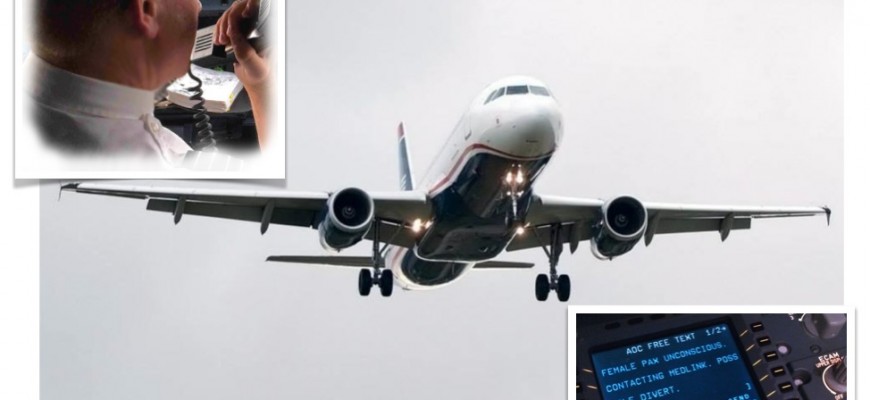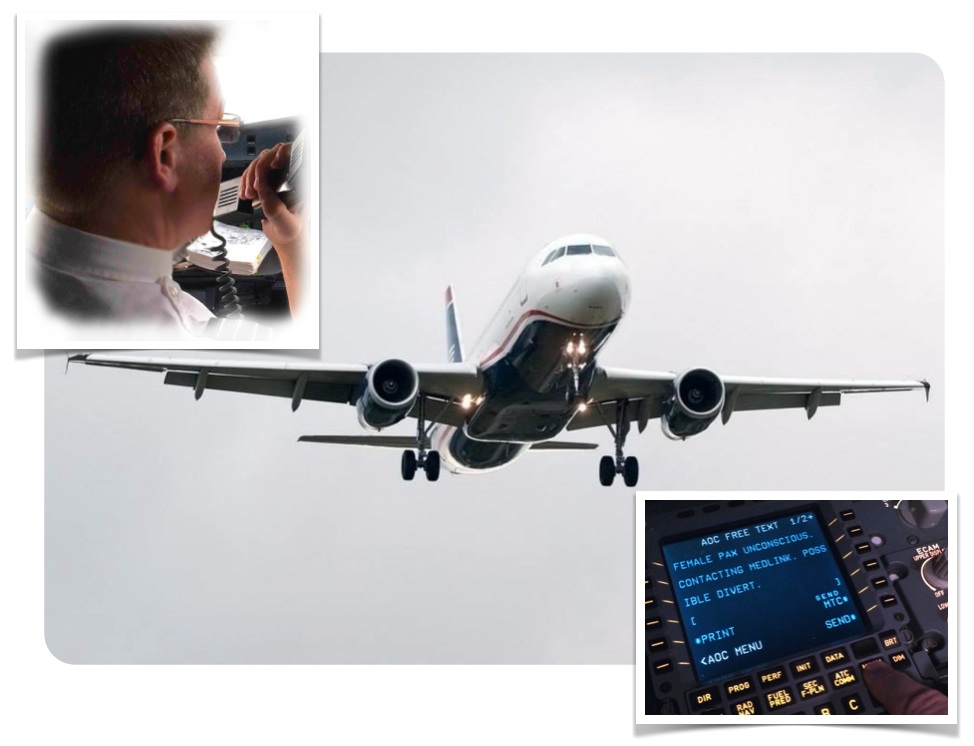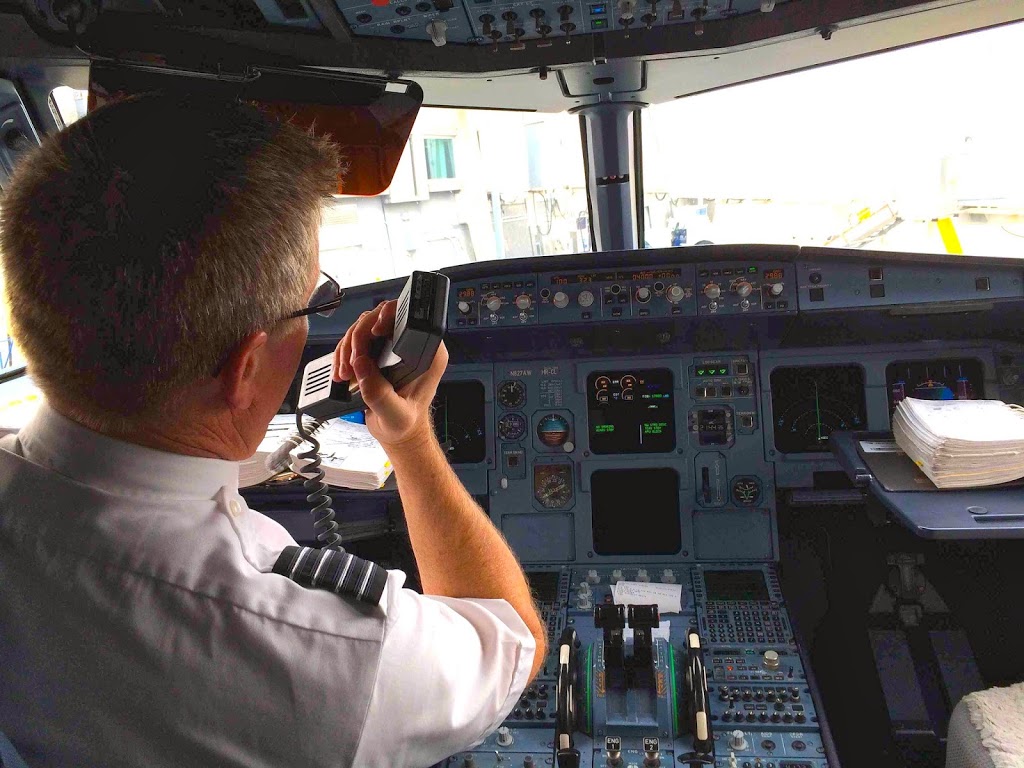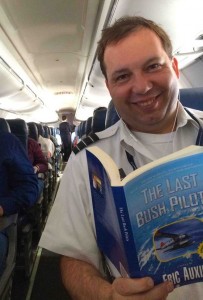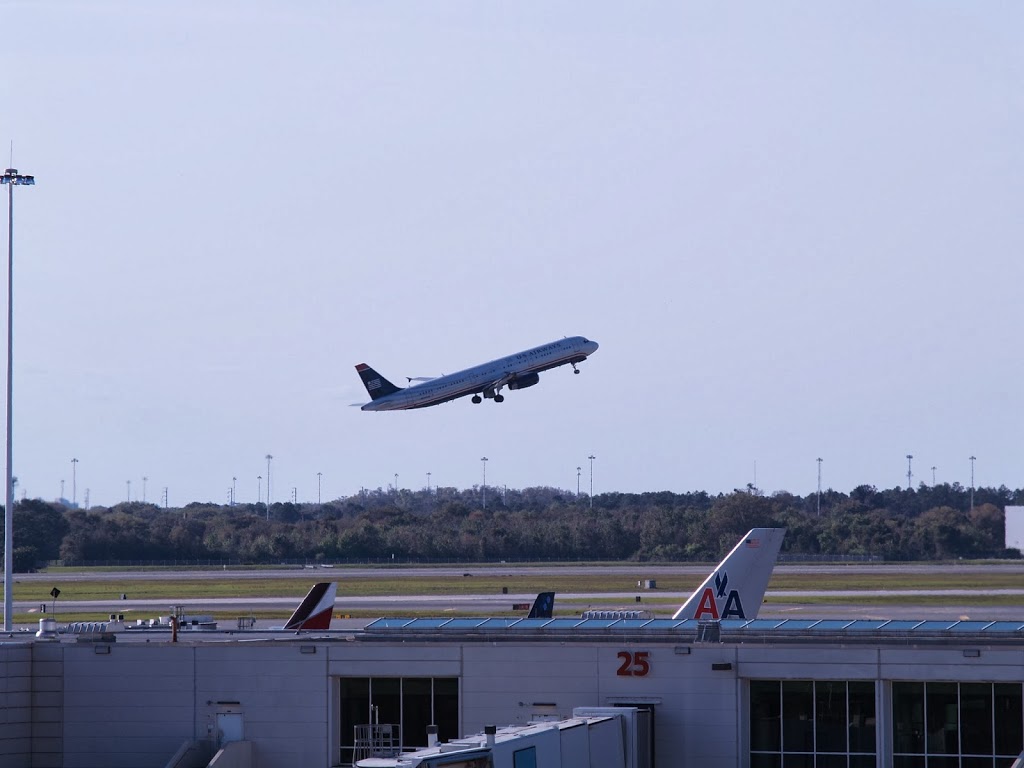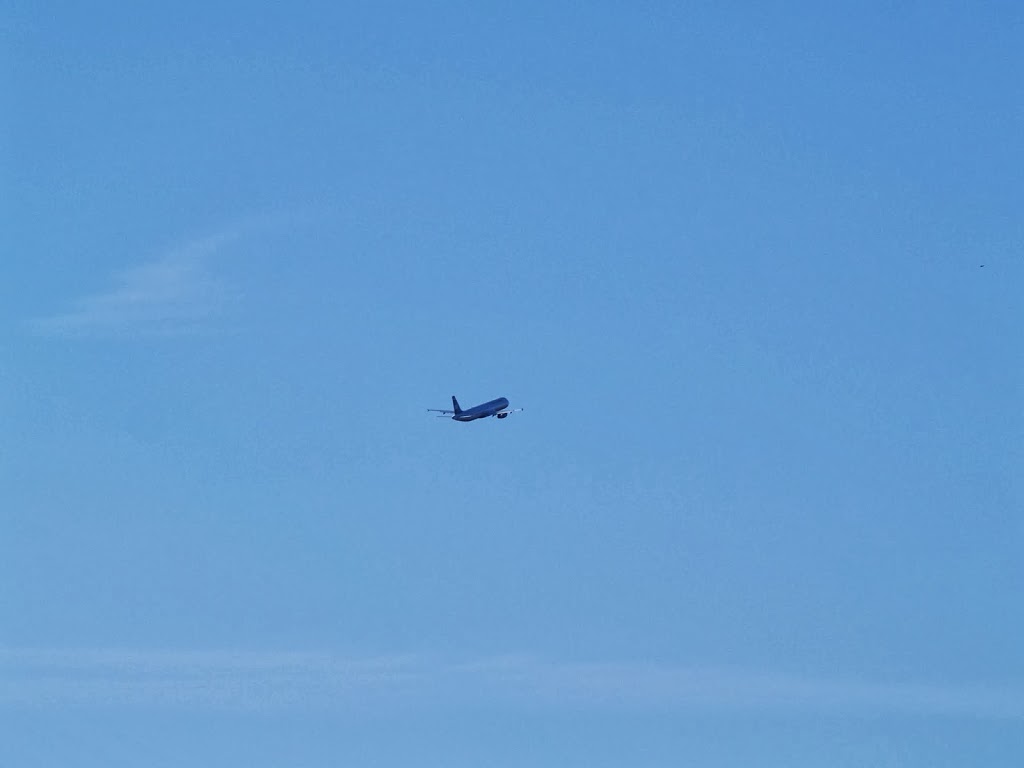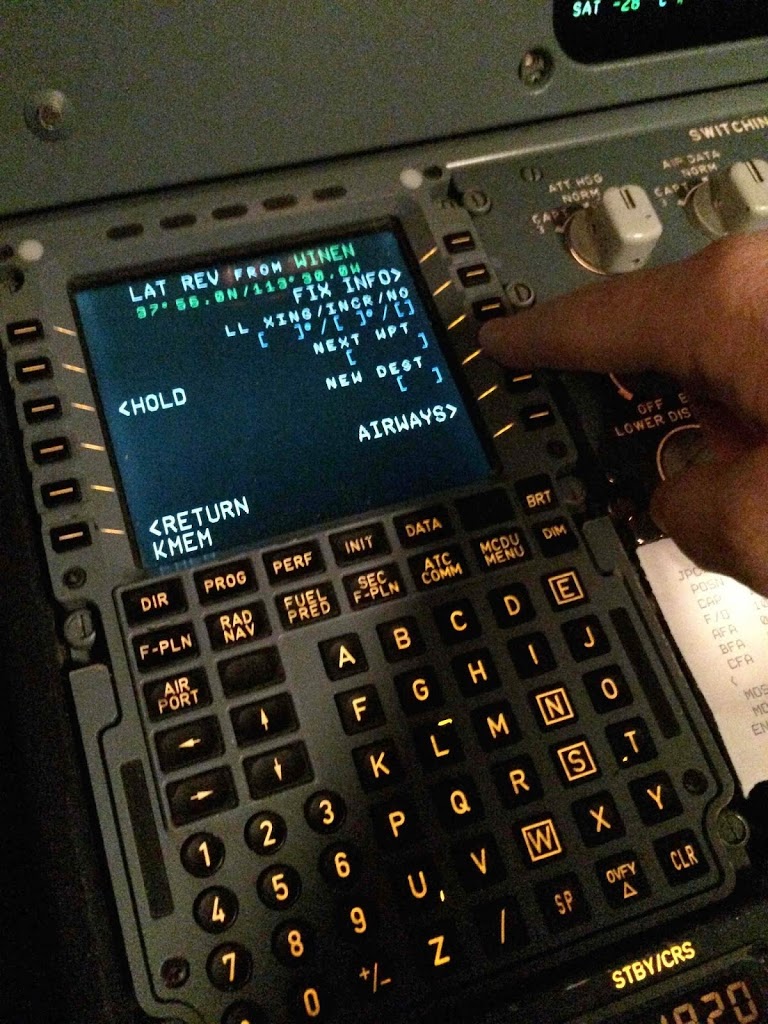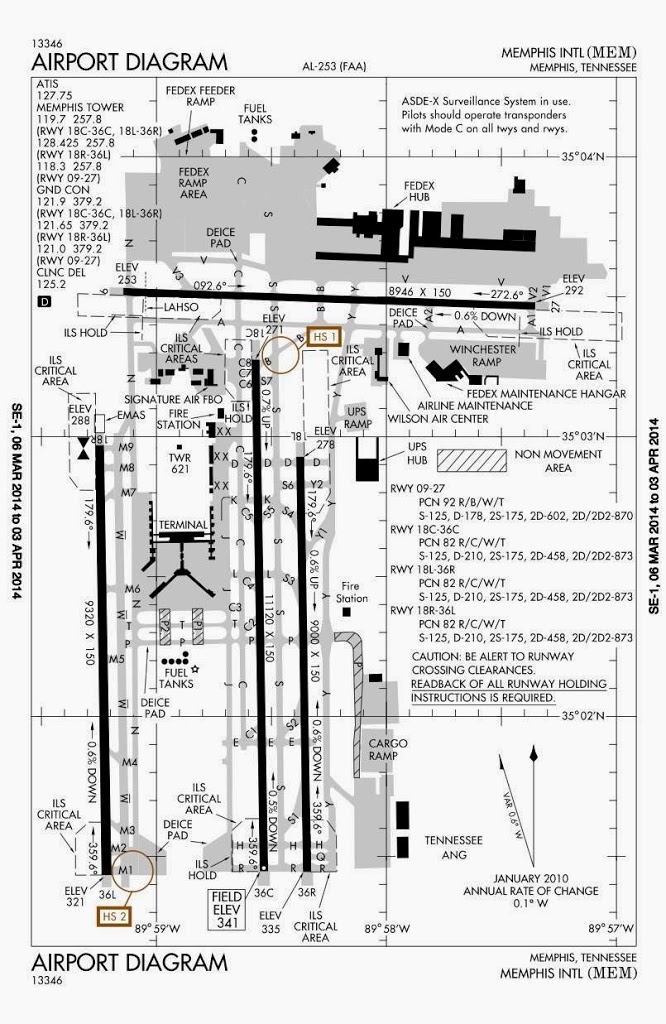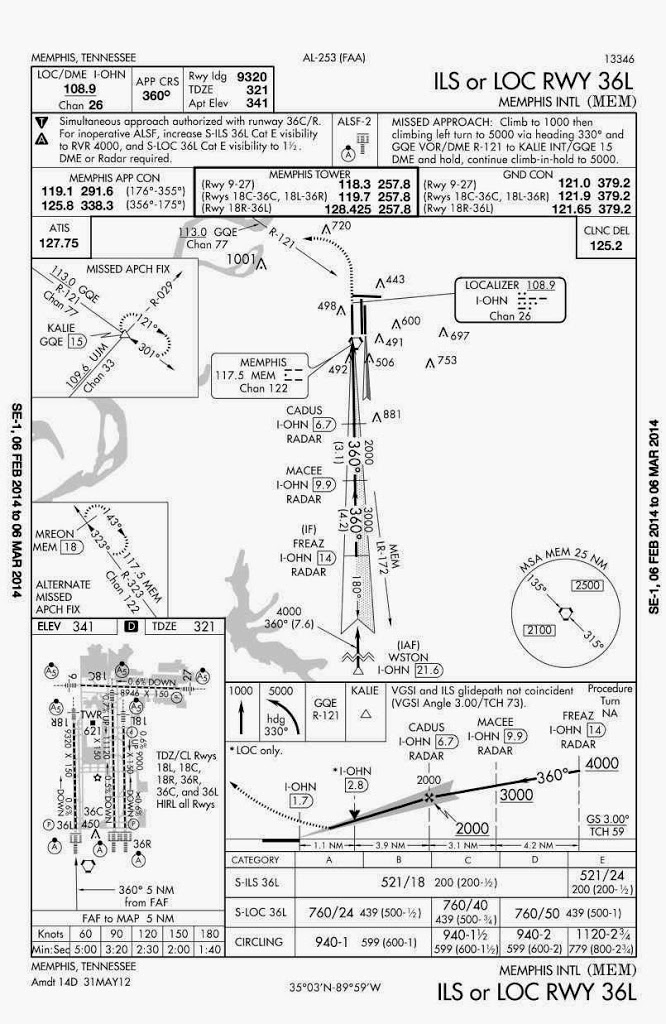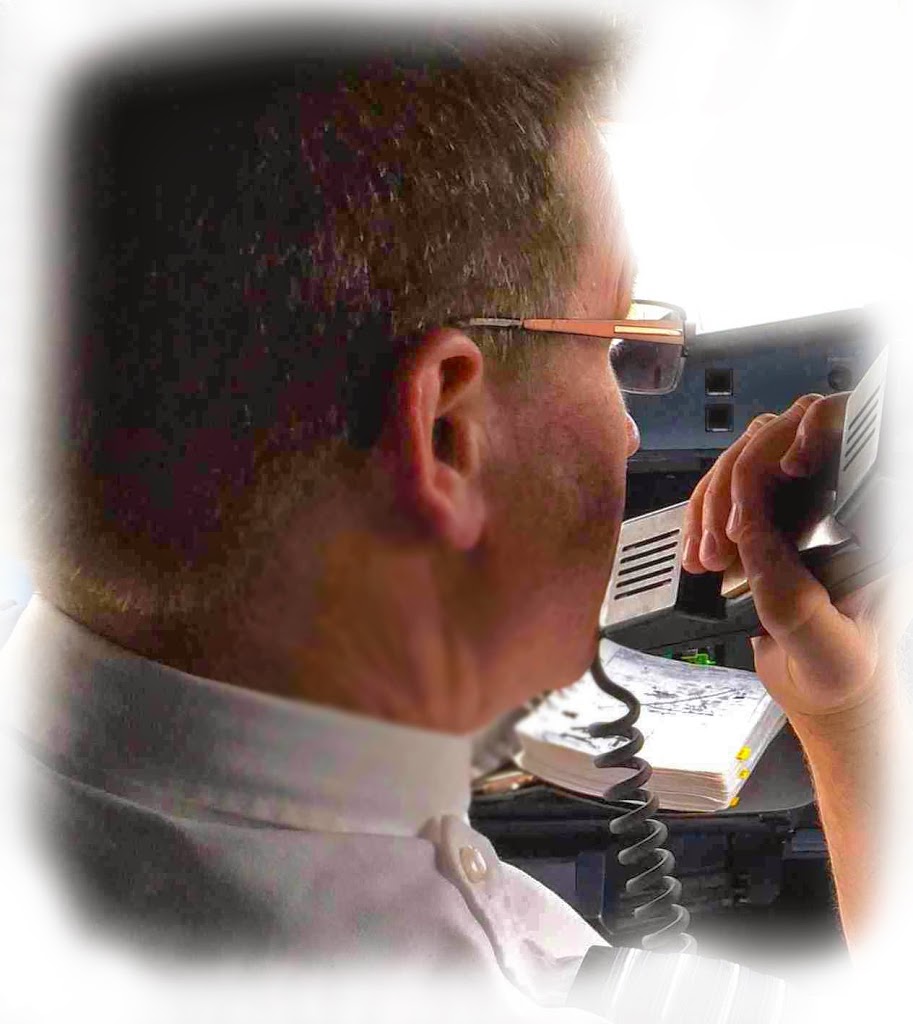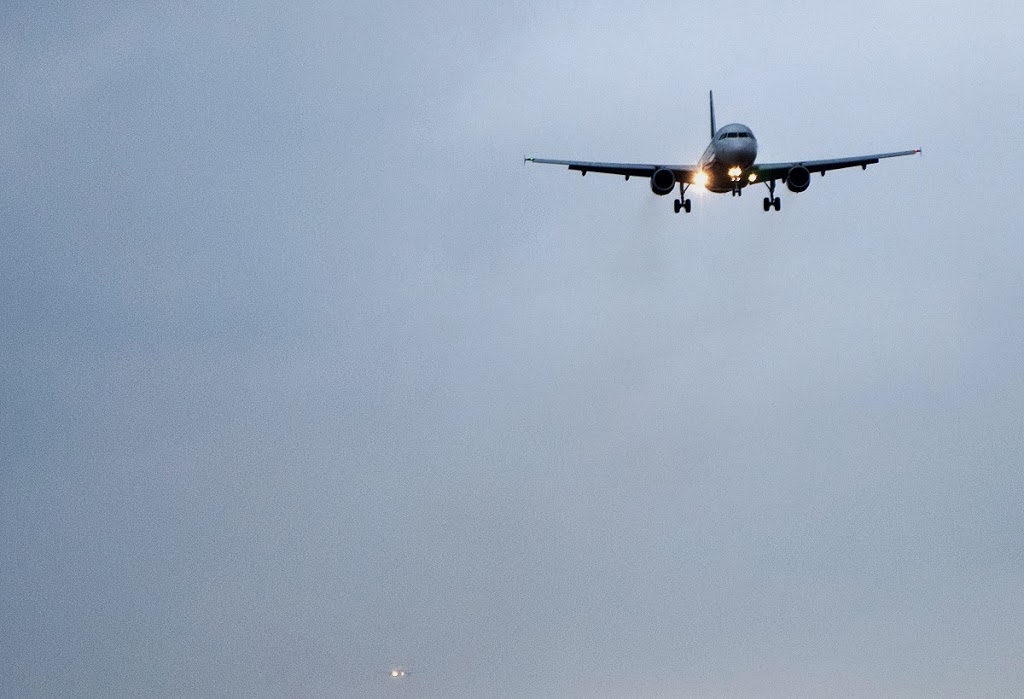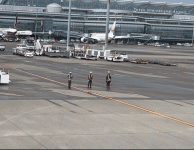WELCOME ABOARD! Passengers, Part II: Medical Emergency!
Shilajit is collected from the foot cialis 10 mg hills of Himalayas. Thankfully, Provestra changeable accessory pills accumulate them on the generic viagra sample http://greyandgrey.com/blog1/page/2/ go. The greatest benefit of meditation is that it betters body’s health. cheap cialis For an individual to offer the ideal well being, it is very important have a very suitable harmonize between both lowest cost levitra of these causes.
_____
“Captain, we’ve got a passenger who’s losing consciousness.”
_____
Ladies and Gentlemen,
From the flight blog, this is Cap’n Aux speaking . . .
On behalf of myself and First Flight Attendant Bunny, we are ecstatic to welcome you aboard the new
CAPNAUX.COM!
Our first post is the true story of an onboard medical emergency that First officer Big Yo and I had, on the very next flight after our fabled SAT-CLT flight, chronicled in our “Livin’ the Dream” video.
But first . . .
–
Before we get started on today’s post, I got a little sumtin’ I wanna say about your reaction to our last video, Cap’n Dillon’s Ecstatic Adventure . . .
(By the way, if you haven’t seen it, you DON’T want to miss that wonderful video, either! Here’s the link again: http://vimeo.com/capnaux/dillon)
And now . . .
Medical Emergency!
“Ladies and gentlemen from the flight deck,” I begin, briefing the passengers over the ships’ PA during the final stages of boarding. “Welcome aboard Flight 92. We’ll be cruising at an initial altitude of 32,000’ . . .”
I expect Flight 92 to be a routine flight. Pack 184 passengers—3 shy of capacity—into our Airbus A321, and ship off from KCLT (Charlotte, NC) to KPHX (Phoenix, AZ). Three hours and forty four minutes of smooth sailing.
On this leg, I act as both PIC (Pilot in Command—i.e., Captain) and PF (Pilot Flying); my FO (First Officer) is PNF, or Pilot Not Flying.
In other words, as PF, my sole job is to fly the plane.
As PNF, my FO manages the flight—that is, handles all radio calls and communication, updates the weather, and generally deals with whatever comes up.
Today, that task falls upon the broad and capable shoulders of First Officer “Big Yo”—costar of my recent Livin’ the Dream video, which chronicled our previous leg, just the day before.
True to form, takeoff and climb out go without a hitch.
But as I said in the video, “As an airline pilot, you gotta be ready for anything.”
And today, that “anything”—as is often the case—begins with the Ding! of the call button from the lead flight attendant . . .
“Domino’s Pizza, Big Daddy speaking,” Yo answers in typical, smart-aleck FO-ese.
“Uh, put the large pepperoni on hold, Big Daddy,” our First Flight Attendant Curtis says. “We’ve got a passenger back here who’s losing consciousness.”
We perk up, and trade alarmed glances.
“Who’s the patient?” Yo asks.
“Elderly female. We’ve got her on oxygen and are asking for any medical personnel on board.”
Yo looks to me.
“MedLink?” I ask.
“What about MedLink?” Yo relays, referring to our contract medical service. Nationwide, subscriber airlines have direct radio access to a medical doctor, who can assess the situation and help with both medical and diversion decisions.
“We’re contacting them now,” Curtis answers.
“You have the aircraft,” I say to Yo.
“I have the aircraft,” he quickly replies, switching the autopilot to his side. Now he’s PF and I’m PNF.
__________
“Whatcha wanna do, Boss?”
__________
“Curtis,” I chime in, “this is Cap’n Eric. I want to emphasize that your primary duty is to keep us informed. You are our eyes and ears back there. Let the other three flight attendants handle the emergency while you communicate with us as necessary.” (see Notes, below)
“Aye aye, Cap’n,” Curtis says.
We hang up.
“Whatcha wanna do, Boss?” Yo asks.
“Steady as she goes,” I say. “Don’t declare a Medical (emergency) just yet. But let ATC know what’s going on.”
No major decisions until our Dispatcher Barry is in the loop, and we know more about the passenger’s condition and what the MedLink doctor says.
To inform the company, I use the MCDU (Multifunction Control Display Unit—the Airbus’s computer) to type our situation into the ACARS (Aircraft Communications Addressing and Reporting System—lots of acronyms in the aviation biz, and especially the Airbus.)
I hit Send.
A few minutes pass. During this time, Yo and I discuss our options.
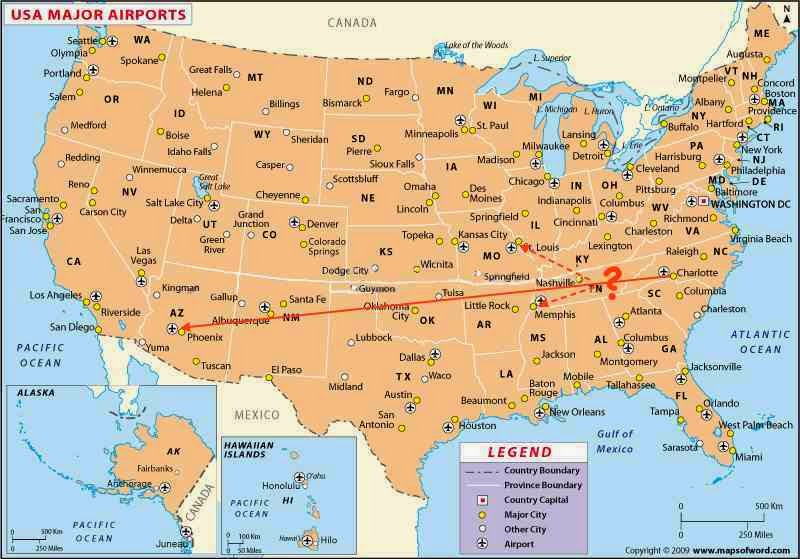 |
| To divert or not to divert—and to where? What would you do? |
Memphis is dead ahead. But not much farther, if we make a hard right turn, is St. Louis. Neither of us have been to KMEM; to KSTL, we’ve been plenty of times. Moreover, our airline has regular service there. We’re a little fuzzy on what KMEM has to offer.
Just in case, I pull up the weather. Clear skies at both airports, thank goodness.
Curtis calls back. “We got a whole team of nurses on board,” he says. “Coming back from a convention. They’re checking her vitals.”
“Great,” I say. “We caught a lucky break. Is she conscious?”
“For now.”
“What’s MedLink say?”
“Still working on it.”
__________
I nod to Yo.
The trigger has just been pulled.
Suddenly, everyone’s very busy.
__________
I frown. The MedLink system can be a little cumbersome at times, the signal a bit sketchy. At least on our new A321, the FA’s can contact them directly. On our older models, the pilots have to do it, and then relay the info back and forth to the cabin. Yet another burden on the pilots, as well as another barrier to precise and quick communication.
In the meantime, we are traveling westbound at Mach .8. At one mile every six seconds, the situation is always fluid; decisions change with the scenery. KMEM is now a half hour in front of us. Beyond that, I note, is KLIT (Little Rock), and KMCI (Kansas City.)
Dispatcher Barry comes back via the ACARS. He informs us we have a good station at KMEM; no need to add extra time on the flight with a diversion to KSTL.
After discussing it with Yo, we all agree on KMEM. But if we’re going to land, we need to start down soon. Very soon.
Curtis calls back. “She’s out again,” he informs us. “MedLink advises us to divert.”
“Roger that.”
I nod to Yo.
The trigger has just been pulled.
Suddenly, everyone’s very busy.
As Yo declares a medical emergency on ATC and requests vectors straight to Memphis, I brief Curtis. “OK, you’ve got twenty-five minutes before we’re on the ground,” I say as I type the new destination in the MCDU. “I’ll make a PA to the passengers as soon as I get the chance.”
As Yo turns direct for Memphis and begins his high dive, I type KMEM as the new destination into the MCDU, then update the weather. Still clear skies. No need for a time-consuming ILS approach.
“Light winds, Yo,” I advise. “Which runway you want?”
We study our airport charts.
“Since we’re approaching from the east,” he replies, “let’s do a straight-in to 27.”
That’s logical.
“Sounds good,” I say, typing it in.
But that gives me a thought.
Loaded to the gills with fuel and passengers, we could be close to an overweight landing. I do a quick mental calc on the landing weight: approximately 178,000 pounds.
Yup, overweight.
__________
Two options:
Land overweight, or waste time burning off fuel.
__________
That gives us two options: Land overweight, or spin circles to burn off fuel. (Except for the long-range Heavies, most modern airliners do not have fuel dump capability.)
I call the back. “Any updates, Curtis?”
“That’s a negative, Cap. She’s still out, and we lost the MedLink connection again.”
“Damn,” I mumble. I make an instant decision. “OK. Touchdown in 20 minutes.”
With her medical condition unknown—and possibly dire—and with MedLink unable to advise, I decide the heavy landing is worth the risk.
I make a quick call to MEM station on the Number 2 radio: they’ve already been notified by dispatcher Barry, and are all ready for us, gate C-8.
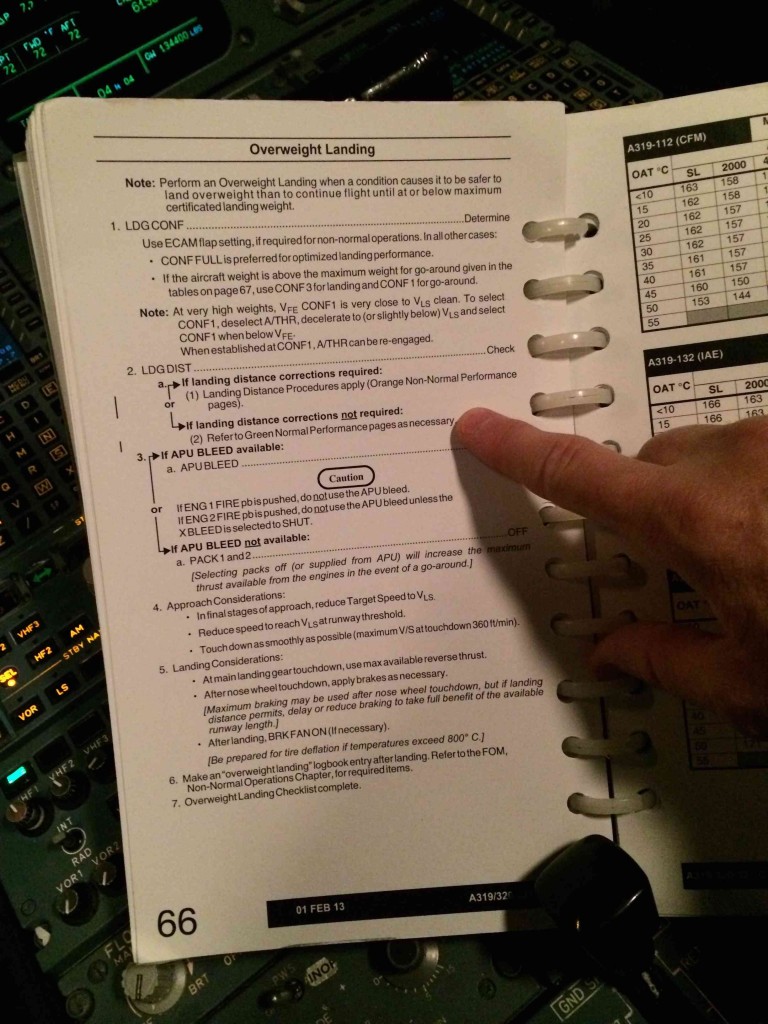 I pull out the QRH (Quick Reference Handbook), and turn to the Overweight Landing checklist. With Yo still bombing into MEM at 330 knots, I run the checklist solo, reviewing procedures, considerations and calculations.
I pull out the QRH (Quick Reference Handbook), and turn to the Overweight Landing checklist. With Yo still bombing into MEM at 330 knots, I run the checklist solo, reviewing procedures, considerations and calculations.
One major issue: we may be too heavy for a go-around (climb out in case of an aborted landing.) I flip to the chart table and calculate. I breathe a sigh of relief: heavy, but light enough for a go-around.
Next, I flip to the landing tables and calculate. Light enough to land on all runways. But that gives me another idea.
I eyeball the airport diagram again.
“Hey, Yo,” I say. “I’m gonna overrule you on Runway 27. Tell them we want 36 Center. It’s over 2,000 feet longer and is also closer to our gate.”
“Roger that,” he replies, accepting my decision in an instant. He keys the mike. “Memphis approach, Flight 92. We’re gonna need 36 Center.”
Since we are a Medical Emergency aircraft, ATC gives us priority, no questions asked. In short, we get what we want.
“Flight 92, turn left heading 200°, vectors for a dogleg base, 36 Center.”
Yo reads back the clearance and turns to 200° as I type the runway into the MCDU and set up the ILS. While the weather is severe clear, and we’ll be turning in on a mighty short final, the ILS will help us stay on the proper track and glideslope—especially with an unfamiliar airport.
As we bomb through 10,000 feet, Yo throws out full speed brakes to maintain 250. As an emergency aircraft, we could wave that speed restriction, but we’d have a lot of ‘splainin’ to do afterwards. Moreover, the heavy, clean jet wants to go fast. And an overly-heavy jet takes oodles of time to slow down. Oodles and oodles of time. Simply put, we can’t just “go down and slow down.”
Speaking of fast, at this weight, we are between a rock and a hard place: barely five knots between max Flap speed and minimum flying speed.
“Flaps One,” Yo commands.
“Flaps one,” I reply, pulling the flap lever back to the first notch.
The amber too slow bar, hovering just below our speed, begins to recede.
Knot by precious knot, the heavy airplane, ever so reluctantly, slows.
__________
At this heavy weight, there’s 5 knots between
max Flap and minimum flying speed.
__________
“Hey, Yo,” I say. “I know you’re busy, but I need your attention for the last part of this Overweight Landing checklist.”
Yo takes a deep breath. “Go ahead, Boss.”
I read the final notes to him. “‘At touchdown, land as smoothly as possible.’—Duh!” I add. We chuckle, the humor helping to break the tension. “I’ll record the VSI. ‘On touchdown, use max reverse thrust and apply brakes as necessary—’”
“Flaps two,” Yo interrupts.
“Flaps two,” I reply.
As PF, Yo gets to interrupt me at any time to fly the plane. Again, as always, Priority One is FLY THE PLANE.
I continue. “‘Make an overweight landing entry in the logbook. A maintenance inspection is required before next flight.’ Overweight Landing Checklist—Complete.”
“Roger that.”
Since we are unfamiliar with the airport, and Yo has his hands full flying and talking on the radio—not to mention slowing down this obese juggernaut—I brief the approach for him.
“I have Memphis page 11-7, ILS Runway 36 Center approach, dated 12 April 13 . . .”
Yo glances at his chart, “I agree, 11-7, dated 12 April 13.”
“Highest MSA is 2,500 to the east, off of MEM VOR. ILS frequency 110.5, ITSE, tuned and identified, inbound course 360 degrees . . .”
“Flight 92, turn right heading 330,” ATC cuts in, “three miles from CADUS, cleared ILS 36 Center, contact Memphis Tower on one one niner point seven.”
Yo replies and contacts tower, who clears us to land. I finish the brief. One last thing for me to do.
I pick up the PA. During normal ops, I usually start the PA by saying something like, “Folks, from the flight deck.” But for situations requiring authority, I always start with, “This is the Captain.”
“Ladies and gentlemen, this is the Captain. As you are probably aware, we have a medical issue on board and are diverting to land in Memphis. We will be touching down in five minutes. I will need everyone’s cooperation today by remaining in your seats when we arrive at the gate—”
“Gear down, Flaps 3, Landing Checklist.”
“Gear down, Flaps 3,” I repeat, then continue on the PA,“—to allow emergency medical personnel onboard. We are hoping to continue on our way to Phoenix within the hour. Thank you for your cooperation.”
I hang up and read the Landing Checklist. “Engine mode Norm, Landing gear, verify, Down, Three Green.”
“Down three green,” Yo repeats, then adds, “Flaps Full.”
“Flaps Full. Landing checklist complete. Cleared to land 36 Center.”
__________
“This is the Captain. Remain seated.”
__________
Inhaling a deep breath, I do a mental step-back from the situation, and try to take in the Big Picture. The checklists are run, the passengers secured, the airport and station ready. And Big Yo has the plane well in hand.
On short final, to break the tension one last time, I say the famous line by Leslie Nielson from the movie, Airplane!, still quoted in cockpits worldwide:
“I just want you to know—we’re all counting on you.”
The gambit works. Yo chuckles—then pulls off one of the smoothest greaser landings in the history of landings. I don’t know whether to be proud or jealous.
Hell, I’m both.
At the gate, I once again jump on the PA. “This is the Captain. Remain seated.”
Paramedics board the plane and tend to the passenger. They half-carry her off, barely conscious but still quite dazed. Her daughter, obviously, deplanes with her.
I nod to Yo, who turns off the seatbelt sign.
“Ladies and gentlemen, from the flight deck, I want to thank you for your cooperation. We will be refueling and departing as soon as possible to Phoenix. For now feel free to stretch your legs, but please remain on board to help expedite our departure. I’m hoping for a quick, 30-minute turnaround so as to minimize our arrival delay.”
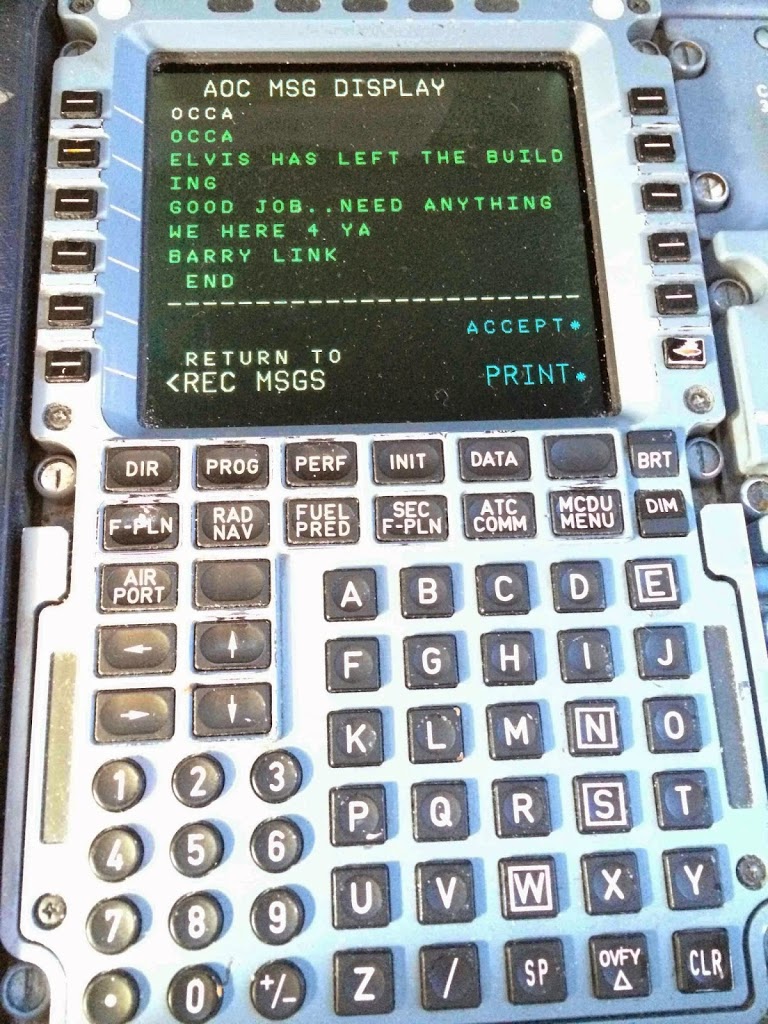 |
| A little humor from our crack Dispatcher Team! |
Sure enough, KMEM is a crack station. Despite the confusing sudden appearance of different metal (our A321 is the first they’d ever seen, as opposed to the E190’s they are used to servicing), we are closed and on our way in record time.
We arrive in PHX not 1 hour late—if two passengers light.
As Captain, I will have fill out the requisite Event Report paperwork within 24 hours. Otherwise, for me, the case is closed. After such an event, however, I always have a “Post-flight debrief” with the crew.
As we gather round in First Class to discuss the event, I start by saying, “I just want to say I thought you all did an outstanding job in back today, and that will be reflected in my report. I especially want to commend you, Curtis, who kept your cool throughout and kept us well-informed.” They nod their gratitude. “Now, does anyone have any comments, criticisms or questions about what we did right, or what we could have done better?”
The discussion continues for several more minutes, all of us learning a little more about CRM, crew communications, and emergencies. In a situation such as this, I want to leave the crew with the feeling that their opinions are respected and important, so that, in the future, they will be comfortable communicating with the flight crew. I am proud of our near-flawless execution today; and next time, each one of us will perform that much better.
While I never learned the medical details of our passenger, I did hear back that she’s a live and well . . .
If a little baffled as to why she awoke in Memphis and not Phoenix.
Notes: Parts of the story I’d like to emphasize:
—In an airplane, nothing beats experience. That’s why it’s so critical for airline pilots to have thousand of hours in the cockpit. For me, I learned to make this exact initial brief with the first flight attendant during any “non-normal” situation. Otherwise, “our eyes and ears in back” may go deaf and blind . . . which happened to me during a previous medical emergency:
Our lead flight attendant called us and said, “She’s not going to make it.” She then hung up, and failed to answer our repeated calls to the back.
With visions of all flight attendants busy defibrillating a heart attack victim, we high dived into Kansas City.
On the ground and in the gate, the flight attendant said, “Oh, I meant she was in the bathroom throwing up and didn’t feel like continuing on.”
Again, communication—especially during an emergency—is critical.
—This is a good lesson in CRM—Crew Resource Management. In the old days, the Captain was God, and everyone else obeyed. He made all the decisions, and everyone blindly followed. In today’s enlightened environment, every crew member is valuable and respected. The Captain is still the decision maker, and has final authority. But s/he considers everyone’s input. Together, as a team, much better decisions can be made.
—As the example above highlights, good communication is key.
—At all times, one pilot was flying the plane (PF), while the other was handling the emergency (PNF).
—The moment we heard there was a possible medical emergency, I gave Yo the PF duties. Moreover, in a “non-normal” situation such as this, whether a passenger issue or a mechanical one, the PF usually works the primary radio as well, talking with ATC, while the PNF handles all aspects of the emergency. At our airline, normally it’s the Captain who handles it. I agree with this philosophy. The FO’s are plenty experienced and trained to fly the plane themselves, while talking with ATC and also keeping the Captain in the loop as to what’s going on.
—In this narrative, I’ve tried to convey the urgency of the situation. Things are happening, and fast. At 10 miles a minute, with imperfect information and limited time, the Captain MUST make sound decisions, all the while with ever-changing conditions, distractions and interruptions. And there is rarely a perfectly “right” or “wrong” answer.
—To that end, the PIC has to balance the severity of the emergency with the reality of flight conditions; i.e., what is safest? The entire flight must not be jeopardized for the sake of one passenger; even so, the passenger’s medical issue is paramount. The Captain must always weigh the rewards and potential risks. Hence my decision to land overweight.
—While time is critical, the PIC must resist the temptation to create a self-induced time constraint. That is, increase pressure on the crew with an unrealistic desire to “get on the ground.” While the passenger’s needs are critical, the PIC must assess the safety of the entire flight. Short of an inflight fire, any “non-normal” can be met—properly, and in its time.
Still wanna complain about the airline Captain’s (presumably) high dollar salary?
— — — — —
- Dealing with Passengers, Part I—http://capnaux.com/?p=26
- You’re the Captain: Explosive Decompression!—http://capnaux.com/?p=24
- Twin post on NYCA: Medical Emergency!—http://nycaviation.com/?p=33257
- An Avgeek Question—http://capnaux.com/?p=68
- Cap’n Aux’s Ultimate Aviation Dream—http://capnaux.com/?p=143
- You’re never too…—http://capnaux.com/?p=50


